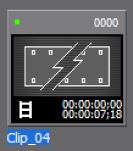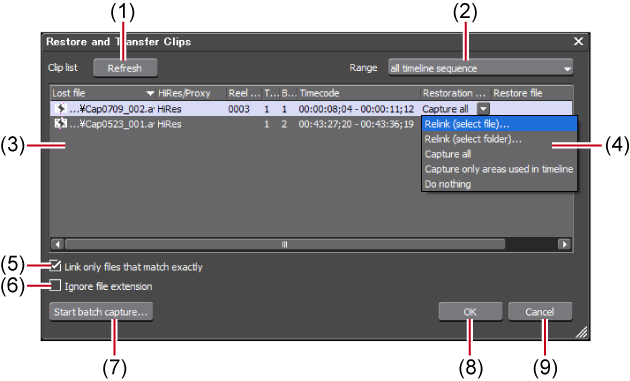EDIUS 7 Online Help
Reference ManualHardware Setup Guide
Installation Manual
User Guide
This section explains how to restore the original source when the source cannot be referenced by the clip.
This function helps to restore the original reference source file when you lost the link from the clip.
Clips registered in the bin are linked with their source. If the source used in a project file is moved or deleted, the clips linked to that source become offline clips.
If there are offline clips on the timeline, an icon to indicate the presence of offline clips and the number of the offline clips are displayed on the timeline status bar.

The offline clips on the bin and the timeline are displayed as below, and the video and audio are both muted during the playback.
Offline clip in the bin

Offline clip in the timeline

Select a restoration method for the offline clips.

The [Restore and transfer clip] selected dialog box appears.
[Restore and transfer clip] Selected Dialog Box
 Alternative
AlternativeClick [File] on the menu bar, and click [Restore and Transfer Clips].
 Note
NoteRegistered clips that are reference AVI files will be marked as offline clips if any part of the source is moved. In such cases, the offline clips cannot be restored.
The reference AVI is a file containing only the audio data entity and destination information, developed by Grass Valley with its own extension within a range of the specification. It is different from regular AVI files.
Files can be captured or restored only when matching the following conditions:
Video information exists.
The reel name is set.
Source file extensions are *.avi, *.m2t, *.mov, or *.mxf.
|
[Capture entire clip ]
|
The [Batch Capture] dialog box appears. Capture the entire source. |
|
[Capture only the area used in timeline]
|
The [Batch Capture] dialog box appears. Capture only the part used in the timeline. If there are multiple offline clips, replace each offline clip with the captured source. |
|
[Find from captured files]
|
Search the source by reel number (Ubit) and timecode (between In and Out points) in already captured files. |
|
[Open the clip restoration dialog]
|
The [Restore and transfer clip] dialog box appears. Restore the offline clips by reestablishing a link to the disconnected source, by retransfer the source that cannot reference a part of the clip, or by replacing a camera proxy file with a high-resolution source. |
|
[Close]
|
Click [Close], and click [Yes] to display the operation screen without restoring the offline clip. |
You can search the source from the hard disk drive to re-link.
The [Restore and Transfer Clips] dialog box appears.
[Restore and Transfer Clips] Dialog Box
 Alternative
AlternativeTo restore the clips on the timeline, double-click the offline clip icon on the status bar. In this case, only the offline clips on the timeline are displayed in the clip list in the [Restore and Transfer Clips] dialog box.
If [Relink (select folder)] is clicked in step 3, select a folder in the [Browse For Folder] dialog box and click [OK].
 Alternative
AlternativeDouble-click a offline clip on the timeline or in the bin window, and perform operations after step 3.

|
(1)
|
[Refresh]
|
Restore clips to which the restoration method is set. |
|
(2)
|
[Range]
|
Select the target range of the clips from the list. |
|
(3)
|
Clip list
|
 : Offline clips : Offline clipsClips whose links to the source are disconnected.  : Clips with restored links : Clips with restored linksClips whose links to the source are restored. |
|
(4)
|
[Restoration Method]
|
[Relink (select file)]
The [Open] dialog box appears. Select the source to re-link. [Relink (select folder)]
The [Browse For Folder] dialog box appears. Search the source with the same name in the specified folder to re-link. [Undo transfer]
Re-link the original source prior to the transition to the project folder. [Capture all]
Click [Start batch capture] to display the [Batch Capture] dialog box to register the information of the entire source. Importing Sources All Together (Batch Capture) [Capture only areas used in timeline]
Click [Start batch capture] to display the [Batch Capture] dialog box to register the clip information used in the timeline. [Do nothing]
Offline clips are not re-linked or captured. |
|
(5)
|
[Link only files that match exactly]
|
Check this item to specify only the files with exactly the same information in the original file to be re-linked. |
|
(6)
|
[Ignore file extension]
|
Check this item to include files with different extensions for re-link. |
|
(7)
|
[Start batch capture]
|
This item is enabled when either [Capture all] or [Capture only areas used in timeline] is selected from the [Restoration Method] list. Click this button to display the [Batch Capture] dialog box. |
|
(8)
|
[OK]
|
Restore the offline clips with the specified settings. |
|
(9)
|
[Cancel]
|
Close the dialog box without restoring the offline clips. |

You can change the default setting of [Restoration Method].
If the source of the offline clips does not exist in the hard drive, you can restore the clips by recapturing from the original source (recorded tapes).
The [Batch Capture] dialog box appears.
Importing Sources All Together (Batch Capture)
 Alternative
AlternativeIn the [Restore and Transfer Clips] dialog box, select either [Capture all] or [Capture only areas used in timeline] from the [Restoration Method] list, and click [OK].
Search the source by reel number (Ubit) and timecode (between In and Out points) in already captured files.
The [Restore Offline Clip] dialog box appears.
Search a file in a folder where the project is saved. If you cannot find the file, click [Select Folder] and select a folder where the captured files are stored, and click [OK].
To restore selected files only, select a clip from [Find clip list] and click [Restore].